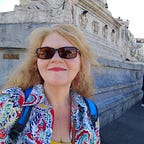Art Travelling: Souad Mardam Bey at the Zamalek Gallery, Cairo
Introduction: Currently based in Cairo, exploring the city’s contemporary art scene.
Syrian-born Cairo-based artist Souad Mardam Bey’s exhibition is titled “I Lost the Key” and the word “key” is evocative in the current times — a key in music, a key to a door (the door to where?) — and what does it mean to lose the key? To sing out of tune? To be trapped somewhere, inside or locked out?
Bey paints, and collages her paintings, in ways which are richly textured and layered in sometimes surprising ways. She brings together different ways of painting, application of diverse materials such as cardboard and photographs and digital prints, and merges them seamlessly into pictures which are deeply engaging and beautiful to look upon.
This painting of a group of people — almost life size — I found particularly stunning. The delicately textured colours, impossible to display on a screen, and the three-dimensional quality of the image due to the application of different materials, made the stylized figures come to life. Somewhere between ancient and modern, they are timeless and eternal as they stand, moving slightly, in silence. And as they hold each other gently, we recollect what we are missing in these times: the soft touch of another human being.
Looking at Bey’s Instagram, I see that she has made many of these group images, and they are all wonderful. But seeing the work in person is very special because of her painting techniques.
A number of the show’s works seem to be ‘characterful,’ that is, pictures of little figures that we might think of as characters, even illustrations. I was reminded somewhat (in a good way) of Russian and Czech animation and illustration, though Bey’s style is fully her own.
However, Bey’s large scale pictures, such as this magnificent depiction of the edifice commonly encountered in the Egyptian countryside, the pigeon house, are more to my taste.
And my favourite of the works I saw? Hard to say, but I suppose it’s this gorgeous rendering of a field of sunflowers. Bey’s approach to an almost hackneyed subject draws on van Gogh, of course, and Anselm Kiefer. Bey puts our eyes right into the field of flowers, not looking over it like a landscape. Nor is it still life; these aren’t dead. They’re living blooms. It really captures the look and feel of the way plants grow here in Cairo, bursting upward from the dusty ground. So much of the city is yellow-beige, but then you get all the plants shooting up and claiming their share of the munificent sun. That is what the painting says to me.
Zamalek Gallery’s text for the exhibItion reads:
The exhibition is part of the artist’s constant attempt at tackling issues that help us explore our inner selves, find answers to pressing questions, and possibly search for lost keys and gates through which we need to pass in order to find inner peace.According to the artist, losing the key epitomizes the state of the world today as it faces the unknown and seems to be endlessly waiting for Godot, a state that is as absurd as that in which Samuel Beckett’s characters are entrapped.Works in this exhibition are rife with symbols of keys and loss of keys. Despite the fact that keys serve only as a metaphor, hence not directly depicted in the paintings, the artist employs a number of signifiers that underline ideas pertaining to the main symbol. For example, the painting placed at the center of the gallery portrays sunflowers in a state between blossoming and withering, between vivacious yellow and lifeless black. The same applies to the pigeon house painting, where the coop symbolizes the confinement we are forced into while pigeons flying around it epitomize the yearned for freedom.”
Zamalek Gallery, Brazil St
Originally published at http://theartraveller.com on January 29, 2021.
